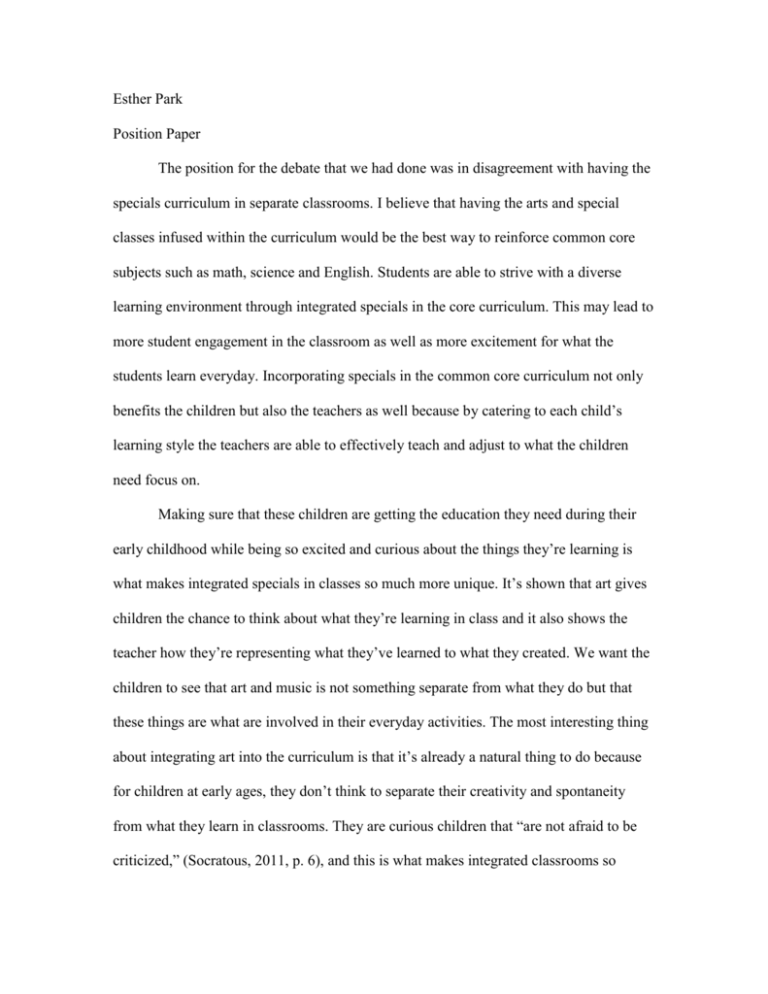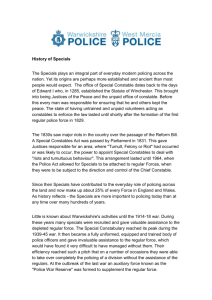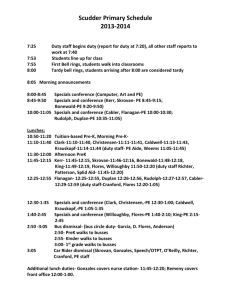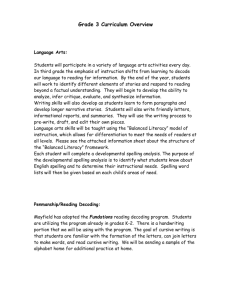Position Paper
advertisement

Esther Park Position Paper The position for the debate that we had done was in disagreement with having the specials curriculum in separate classrooms. I believe that having the arts and special classes infused within the curriculum would be the best way to reinforce common core subjects such as math, science and English. Students are able to strive with a diverse learning environment through integrated specials in the core curriculum. This may lead to more student engagement in the classroom as well as more excitement for what the students learn everyday. Incorporating specials in the common core curriculum not only benefits the children but also the teachers as well because by catering to each child’s learning style the teachers are able to effectively teach and adjust to what the children need focus on. Making sure that these children are getting the education they need during their early childhood while being so excited and curious about the things they’re learning is what makes integrated specials in classes so much more unique. It’s shown that art gives children the chance to think about what they’re learning in class and it also shows the teacher how they’re representing what they’ve learned to what they created. We want the children to see that art and music is not something separate from what they do but that these things are what are involved in their everyday activities. The most interesting thing about integrating art into the curriculum is that it’s already a natural thing to do because for children at early ages, they don’t think to separate their creativity and spontaneity from what they learn in classrooms. They are curious children that “are not afraid to be criticized,” (Socratous, 2011, p. 6), and this is what makes integrated classrooms so beneficiation because the teachers are able to bring out the creativity during their lessons that the children hold onto and make them curious to know more and think more about what they’re being taught. When I was in 3rd grade, I would remember the only interactive activities during math and science time was with my group table and having to do worksheets together or just coming up to write on the board when we did class activities in our seats. It wasn’t engaging and it didn’t seem interesting to me. But during my time at the SUM Childcare Center, I was able to see how these children were able to explore with painting and coloring as they learned about colors and how they were able to draw and do little dances of different types of transportation as they learned about transportation that week and were able to run around outside with the teacher and learn about the way the leaves change during the fall season. This showed me how these activities in the classroom engaged all the students and made the children want to learn more and ask so many questions each time I was there. Even though they were only preschool children, this was letting the children speak their mind and this, “creates a more comfortable and exciting environment for learning,” (Socratous, 2011, p. 4). We had spent some time talking about how important community in a classroom is for the students and being able to allow the children to feel included and comfortable in a safe environment where the teachers get to know the students more with what their weaknesses are to help them improve them gradually and to bring up their strengths in and out of the classroom. Integrated specials is what is best for the children with allowing the teachers to know what they’re struggling in and what they can do to encourage students to learn from one another as well. Specials should be a fundamental part of what children do everyday that is incorporated into the curriculum instead of something that is separated into different components. There is always a natural connection between integrating arts and sciences because the things that children learn can be exciting with incorporating along with music and arts. It helps the children to remember lessons taught when a creative activity is something they would do with what they’re learning whether it’s a song, a dance or a craft they make together. Also, understanding that the early years of childhood hold crucial time periods in physical, mental and social growth, educating students through the integration of specials in a single classroom allows for more productivity time where they won’t feel rushed, and can focus on what’s being taught. Having students travel to separate classrooms to go to these separate special classes waste valuable time and can be very distracting for the young students when they’re headed from class to class. But integrated specials in curriculum can be a smooth transition where breaks are given, and it’s a more flexible time for the teacher to have the children be engaged in what they’re learning. It was stated in an article, “Turn that excitement into questions for science investigations,” (Manner, 2002, p. 19), and I immediately thought about how the little things that catch their attention such as snowflakes, seasons and the changing of colors outside can just lead into a fascinating class research project that brings all the children together. Learning through the arts would represent the ways of their learning and even the teacher’s approach to teaching this with also the approach from the students for the curriculum being taught. It states in the Journal For Learning Through the Arts, “…a creative approach to life is so natural for children…” (Socratous, 2011, p. 2). This quote speaks truth for all children because they are just curious about everything, and being able to approach all the questions they have with experimentations whether its with colors or their creative drawings, would show what they enjoy learning with and be able to express themselves through that. The specials infusion into the curriculum in the classes would not only lead to deeper understandings for the children but also just creates an environment that they feel comfortable in and are not hesitant in expressing what they enjoy and who they are. References: Economidou, Natassa S., Smaragda Chrysostomou, and Harris Socratous. "Music Learning in the Early Years: Interdisciplinary Approaches Based on Multiple Intelligences." Journal for Learning through the Arts (2011): 1-13. Web. Manner, Jane C. "Arts throughout the Curriculum."Http://search.proquest.com/docview/232056299?accountid=9784. Kappa Delta Pi Record, n.d. Web.









